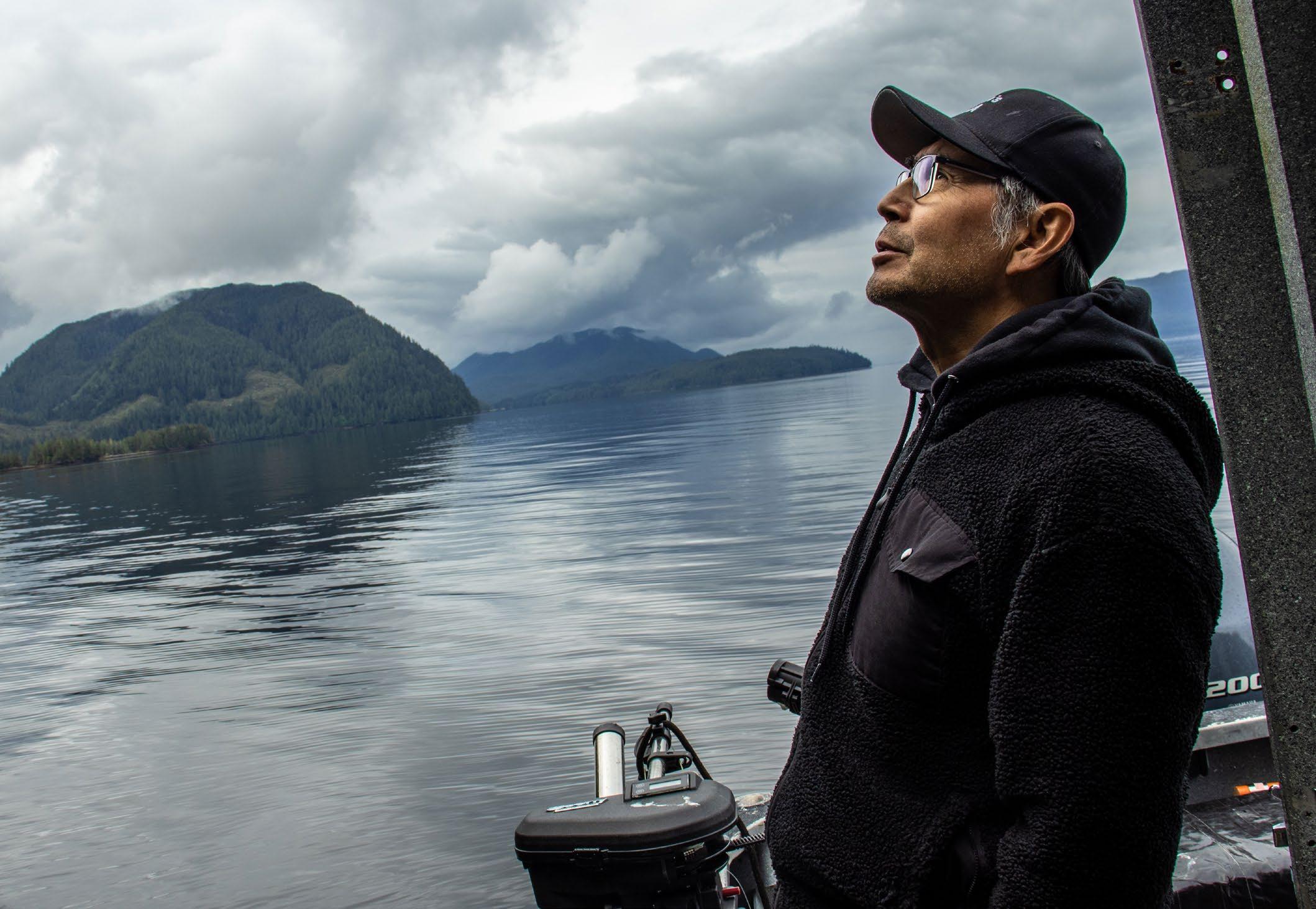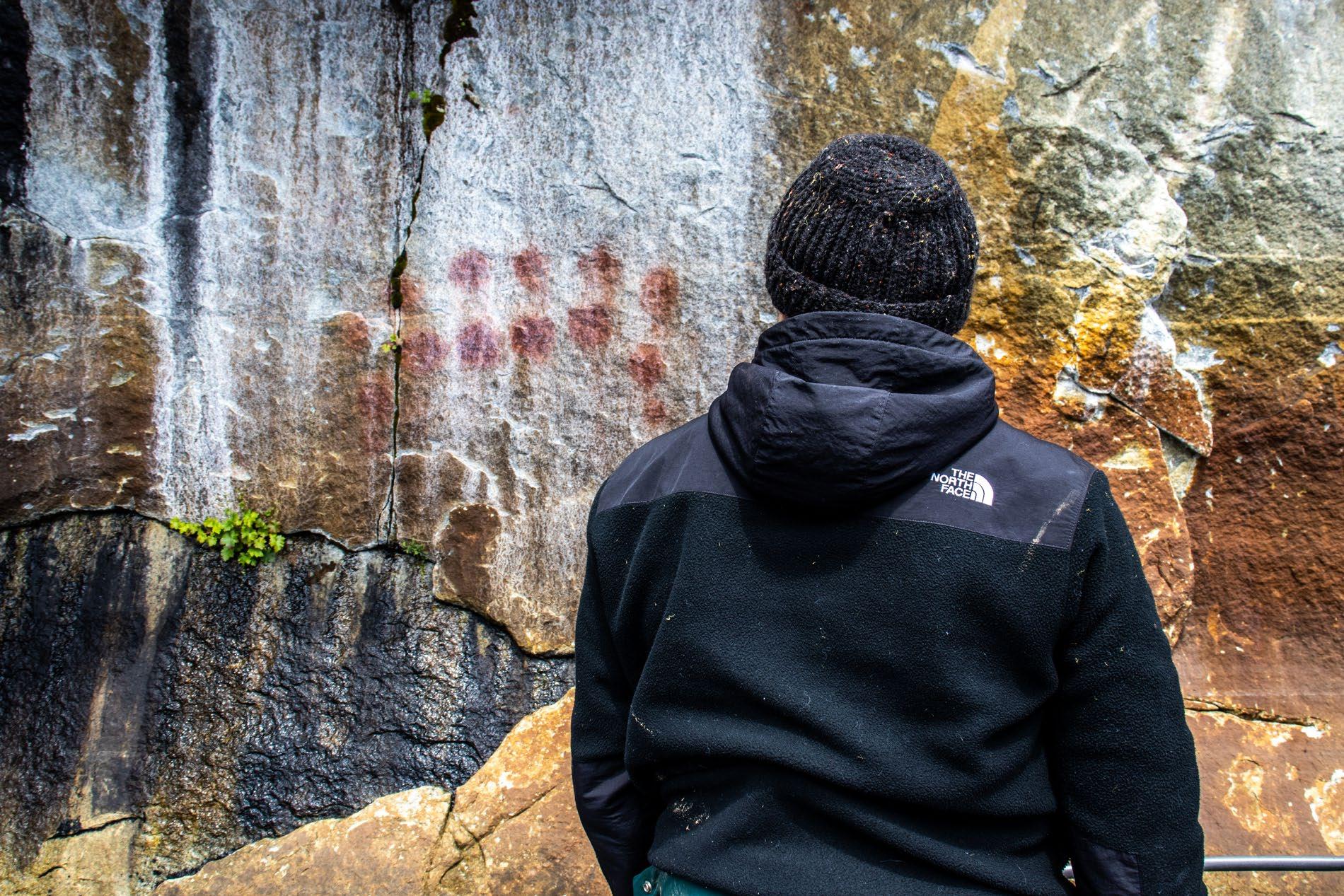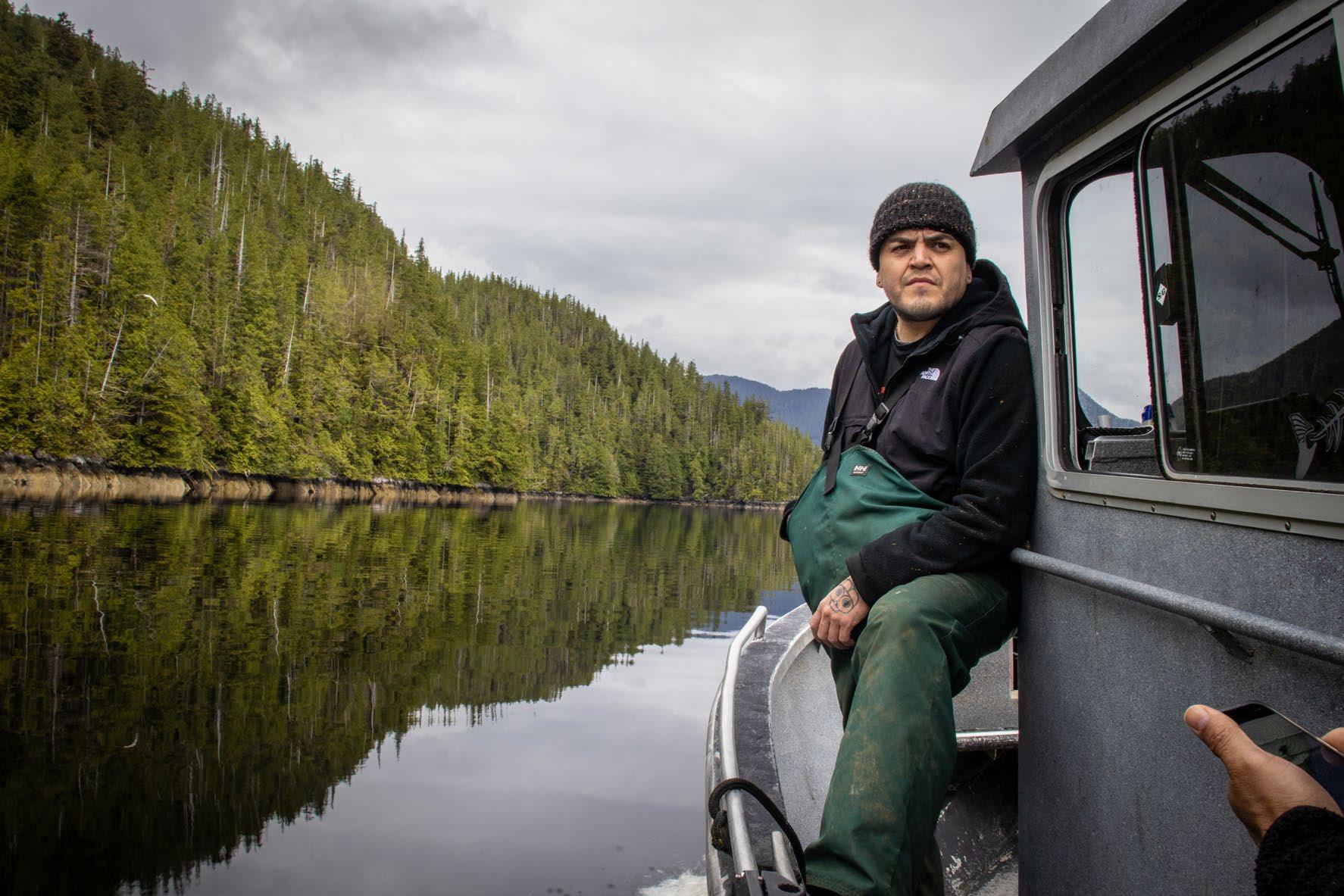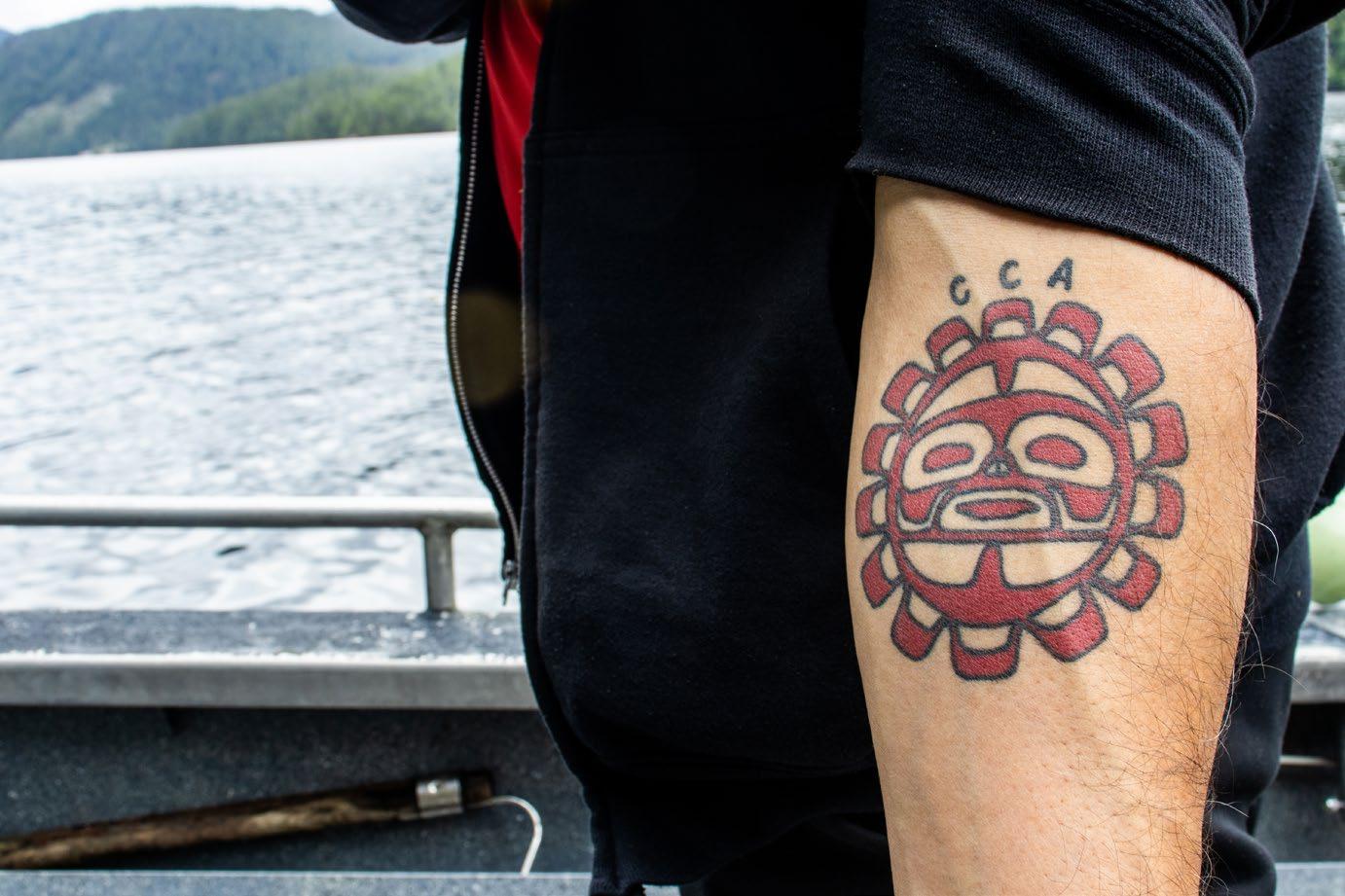
9 minute read
Haíɫzaqv Archeologist Practices Mṇúxvit
Haíɫzaqv Archeologist Practices Mṇúxvit Approach to Ancestral Work
By Emilee Gilpin Coastal First Nations
HAÍŁZAQV ARCHEOLOGIST Q̓ÍXITASU Elroy White and his nephew Charlie Brown cruise through their territory by boat, visiting old stone fish traps and culturally modified trees, scanning the bases of bluffs for rock paintings, carvings or evidence of burial sites.
Each visit or new archeological find connects them to their Haíɫzaqv ancestors, reminding them continuously of their intergenerational presence and spiritual and cultural rights and fortitude. “I’m an independent archeologist. I live and operate out of Bella Bella,” says Q̓íxitasu, as he and his skipper wait for his nephew who jumped on shore. “Charlie is looking at the base of this bluff for rock paintings, carvings and burial boxes.”
These are all artifacts they’ve found throughout their Haíɫzaqv (Heiltsuk) territory, some identified by other archeologists before, marked or mismarked on maps, some they are identifying for the first time. What matters after the find, Q̓íxitasu says, is the interpretation one makes of it.
Haíɫzaqv archeologist Q̓íxitasu Elroy White observes rock bluffs looking for the evidence of burial sites or other artifacts. Photo provided by Coastal First Nations.
More than just looking
Q̓íxitasu has a Master of Arts in the Department of Archeology from Simon Fraser University. His thesis, “Heiltsuk Stone Fish Traps: Products of my Ancestors’ Labour,” incorporates local Haíɫzaqv political and cultural entities and the stories from 12 Haíɫzaqv oral historians.
“According to Heiltsuk oral history, we have used and occupied this diverse marine environment and landscape, including rivers and offshore waters, since time immemorial,” writes Q̓íxitasu in the introduction of his thesis.
“We are reminded continuously of our ancestors’ presence. Old village sites, rock art visible on cliff faces and carvings on slippery rock surfaces, scars from bark strips on cedar trees, burial sites and stone fish traps are the remnants of their tenure.” “Anybody can look and find. The important part of being an archeologist is that you do the analysis, the lab work, the reporting and then you come up with an interpretation,” he says. “My work includes way more important parts than just looking, searching.”
Q̓íxitasu practices what he has come to identify as a Mṇúxvit approach to the work. Mṇúxvit is a Haíɫzaqv word that loosely translates to English as “uniting, becoming one.”
Archeological evidence validates Haíɫzaqv oral history—the excavations at an ancient Haíɫzaqv village site of Máwás (Namu) reveal 10,000 years of continuous occupation; an excavated settlement site on Triquet Island dates 14,000 years ago, during the last ice age.
While archaeologically ancestral sites and artifacts tell a story of the presence and continuous use and occupancy of a Nation group, Q̓íxitasu says that from a Haíɫzaqv perspective, there’s more ceremonial, cultural and social information that’s shared internally.
There were many times throughout his studies and field work he realized his cultural protocols and context governed his
By Eva-Maria Boehringer, RPBio
On the surface, archaeology and biology are two very different disciplines: the former studies human history and pre-history through material remains, while the latter investigates the function of living organisms, their habitats and the ecosystems that sustain them.
Especially when viewed through the lens of western science, these two fields don’t seem to share any commonalities. However, when we apply the broader scope of Traditional Knowledge (TK), the bridge becomes clearly visible, and we can see that both disciplines fit under the same umbrella.
TK uses a placed-based, cultural approach to the collection and interpretation of information, using wisdom and knowledge that has evolved over thousands of years of living as part of the environment. This knowledge, which is passed down orally through storytelling and mentorship, is broad, holistic, place-based, relational and intergenerational.
When it comes to the practice of biology, western science views ecosystems as intact in the absence of humans; in fact, to fully restore an impacted system means to bring it back to how it functioned before human-caused impacts occurred. TK tell us that humans are an integral part of the natural world and that we are just one more component of a vast and complex system. All living systems, including species, habitats and their interactions, tell a story over time about changes in the environment, just like archaeological sites and artifacts tell a story over time of the presence and continuous use of an area.
Western science and TK both recognize that knowledge is always growing and changing, that observations are critical for recognizing patters and causality in nature, and that ecological systems are complex. By learning about TK, and how this expert knowledge about a specific ancestral region is used in day-to-day life, we gain a more holistic understanding of our environment and the relationships among all beings, including humans, who are a part of, not separate from, the whole.
work differently than other archeologists. In his research and work, Q̓íxitasu combines many approaches, practicing a new, yet ancient methodology, uniting many ways of doing things into one. He consulted Rory Housty, a Haíɫzaqvḷa (Haíɫzaqv language) speaker and teacher, and Elizabeth Brown, his motherin-law (fluent Haíɫzaqv speaker), explaining his methodology, to find the appropriate Haíɫzaqv term for his practice. “The fact I use a Haíɫzaqv word empowers me. That’s how my ancestors would have done it, they wouldn’t have used an English word. I use our language to help interpret these sites created by my ancestors rather than the English words that tend to lose their meaning,” he says.
here, I have protocols I must follow,” he says. Sometimes, it’s his nephew who gives him the nudge if he forgets to sing. Younger generations are often taking up protocols others do out of habit or respect, he says, but they really mean it. “We do that when we come to a village where we know a song In his research and work, came from, or we’ll do a dance Q̓íxitasu combines many on the bow, we’ll chant, it’s so empowering, it brings life back to approaches, practicing a new, these places.” yet ancient methodology, Charlie, Q̓íxitasu’s nephew, who’s uniting many ways of doing the co-founder of a growing things into one. Haíɫzaqv art and clothing company HstryMkers, says it’s not that they “don’t like outsiders coming in,” but having Haíɫzaqv people identifying their own ancestral artifacts charges the work with a different meaning.
When Q̓íxitasu and Charlie arrive to a burial site and point to some of the artifacts resting there—a rattle, pieces of a box with formline drawings—, Q̓íxitasu chants. “I have ancestry “Nobody in the world will have the connection we have to any of this. They won’t have that feeling we get when we
Charlie Brown looks at rock paint left by his ancestors. Photo provided by Coastal First Nations.

Haíɫzaqv member Charlie Brown says having his people identifying their own ancestral artifacts charges the work with a different meaning. Photo provided by Coastal First Nations.

put our hands on the rock, they won’t have that cultural connection,” Charlie says.
The tangible and intangible
“When you’re sharing knowledge in a potlatch, you say ‘this song belongs to, this history belongs to,’ and you have to say the name, you can’t blurt out information without acknowledging that sort of thing,” he says.
Other major differences Q̓íxitasu encountered in his research was the way that people were documented, analyzed or cited by archeologists.
“Everything was from the scientific approach. It was acceptable to be going into burials and taking things that didn’t belong to them for their analysis and later for their own interpretation,” he says. “Often they would throw in a tokenism about the Haíɫzaqv or wrongful interpretation to Kwakwakaʼwakw or Haida, Tlingit, etc.”
In his research, Q̓íxitasu would come across information that wasn’t appropriately sourced. He’d find the name of the person who conducted the research but not always the person who provided the knowledge.
“Any researcher, we’re trained to build on what’s already existing, but that also includes the oral history, who said it before,” he says. “I knew when I wrote my thesis I would quote people perfectly, the way we do it in our potlatch.” He doesn’t fault the “people who did the work previous to us,” he says, but a place-based cultural interpretation adds important information to the pre-existing database. His work extends beyond the physical artifacts, the main focus for many archeologists—it’s about the tangible and the intangible, he says.
“The rest, the socio-cultural part of it, what’s embedded in that, how it was used, why it was used, where it was used, when it was used, how long it was used are all important,” he says. “All of the artifacts, village sites, products of my ancestors’ labour, are all reinterpreted as Łáxvái.”
Łáxvái means strength or right of descent, he says. It’s a term and concept fundamental to the potlatch governance system and remains rightfully present in his work. Q̓íxitasu uses his culture, potlatch knowledge and history and puts it into the reinterpretation of these artifacts.
“All of those physical tangible artifacts were made through Łáxvái, through the strength and right of these people to make an
artifact. Selection of these places wasn’t based on preference, it’s because an ancestor descended down and the descendants inherited it,” he says.
Finding balance
Q̓íxitasu admits to sometimes feeling isolated in the work. He’s proud to be an archeologist, he says, and he fits in with others in his field to an extent. But there are aspects of his Mṇúxvit approach that others can’t relate to. He’d love to work with more archeologists from neighbouring Nations, he says, and compare their finds, culturally-based approaches and interpretations.

Elroy White’s tattoo proudly represents his organization ‘Central Coast Archeology’. Photo provided by Coastal First Nations.
“I have struggles internally and externally, and have to find that balance,” Q̓íxitasu says. “That balance is the Mṇúxvit approach.”
He engages with other archeologists, reaching out to ask technical questions about lab work or keeping up to date with “what’s new in western science we don’t know here in the village,” he says. Q̓íxitasu has named his independent business Central Coast Archeology (CCA), since that’s the region he works in, his ancestral homelands and waters. Recently, he’s been learning how to fly a drone, accessing new technology to offer more expansive views of their lands, waters and ancestral markings.
He hopes he and others doing the work can inspire youth in the community. He often works with youth in land-based healing outings, bringing them to visit sites, sharing stories, songs, artifacts. “If anybody wants to learn about rock art locations, interpretations and analysis, they don’t have to go to the arch branch or main library, they come to the source, the culture centre or the HIRMD1 office,” he says.
Q̓íxitasu says he never uses the word “decolonize” but he’s been told that that’s what he’s doing.
“People tell me, ‘you’re decolonizing archeology,’” Q̓íxitasu says. “I don’t know that. I’m just doing what I think is right and don’t care what other people say. We’re just rewriting history, that’s all we’re doing.”
Published with Coastal First Nations’ permission.
More information:
> https://coastalfirstnations.ca/
“They’re so used to seeing all these graduate students and outside people coming in and doing the work,” he says. “We’re doing it ourselves. It’s a great sense of accomplishment that we’re doing this where our ancestors were.”
Q̓íxitasu says they don’t publish their findings and rarely share outside of the community. It’s work they do internally, he says, “almost like what we do in our potlatches, sharing our oral history.”
1. Heiltsuk Integrated Resource Management Department








